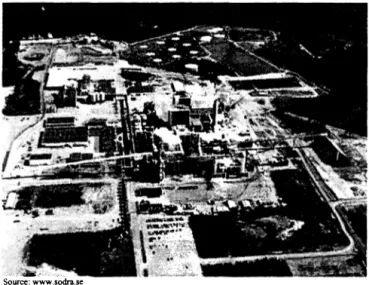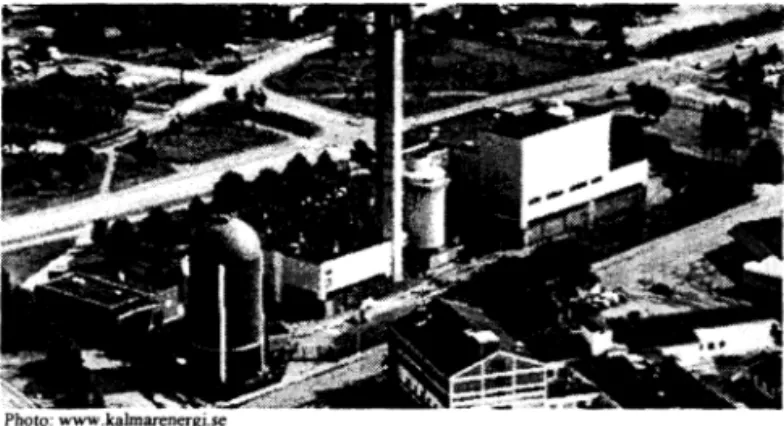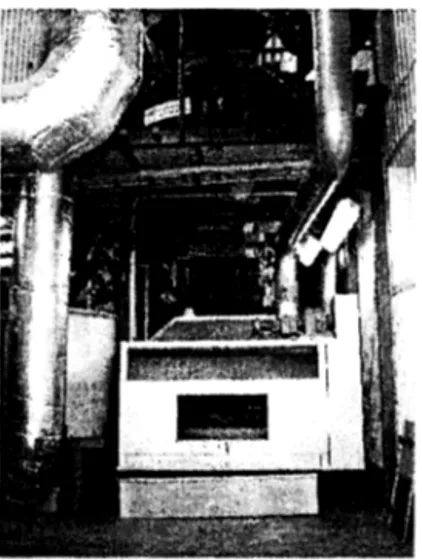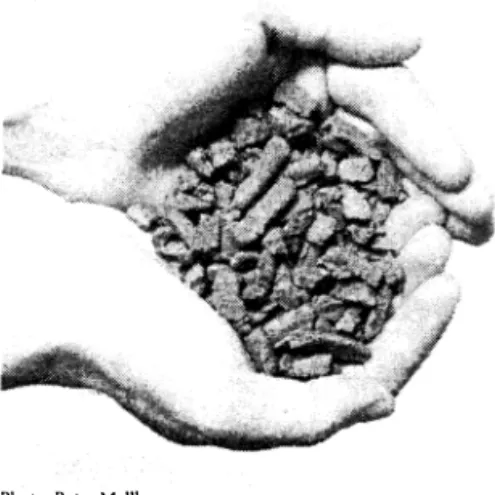Kalmar ECO-TECH '05 and
The Second Baltic Symposium on Environmental Chemistry KALMAR, SWEDEN, November 28-30, 2005
NUTRIENT RECYCLING BY USING
RESIDUES FROM FOREST INDUSTRY
Tommy C/aesson
Sirkku Sarenbo
Peter Me/Ibo
O/of Stalnacke
University of Kalmar, Sweden
ABSTRACTA major part of residues from pulp industry are deposited as waste at high disposal costs. This paper summarizes a five-year research project concerning implementation of an industrial, automatic roll-pelletizing method at a heating plant in the city of Kalmar, Sweden and presents the visions of the newly initiated research project where pulp industry residues are recycled together with wood ash. Also combustion issues are included.
KEYWORDS
Biomass fuel; Ash; Pulp industry residues; Recycling; Combustion 1. INTRODUCTION
Management problems concerning ash from biomass fuel incineration as well as residues from pulp processing are common for many industrial companies. The production of biofuel ash and 1 pulp processing residues are estimated to be approximately 270 000 and 220 000 tons yr· , respectively, in Sweden [I]. A major part of these residues are deposited as waste at high disposal costs. On the acidified soils of southern Sweden, clean biomass fuel ash recycling is recommended by the forestry authorities in connection with whole-tree harvesting where also the nutrient-rich parts of trees such as bark, branches, tops and needles are removed from the forest. Transformation of ash into less reactive material is required in order to facilitate ash spreading on forest soils and to slower their decomposition rate.
The mineralogical composition of biomass fuel ash varies depending on the fuel origin and properties, what kind of boiler is utilised and also on the combustion conditions, e.g. the combustion temperature. Biomass fuel ash may contain CaO up to 30 % (dry weight basis), that is very reactive. In order to make wood ash less reactive, they are hydrated by water addition. Ca(OH)2 (slaked lime) is instantly formed and carbonation (forming of CaCO3) will follow more slowly. Sometimes also additives (organic or inorganic binders) and heating are used in order to increase the hardening rate and the mechanical strength of the final material.
Kalmar ECO-TECH '05 and
The Second Baltic Symposium on Environmental Chemistry KALMAR, SWEDEN, November 28-30, 2005
2. RESIDUES FROM THE FOREST INDUSTRY
The Swedish forest industry produces huge amounts of waste every year. For example, in year 2000, the amount of ash produced by the Swedish forest industry was approximately 270,000 tonnes and the amount of green liquor sludge 220,000 tonnes [I]. Approximately 70 % of the ash and almost all the green liquor sludge were deposited. Both wood ash and green liquor sludge contain a lot of nutrients. Green-liquor sludge contains generally 30 % Ca, 4 % Mg, 3 % Na and I % P. Wood ash may contain about 15 % Ca, 7 % K, 4 % Mg and I % P. Both materials also consist of a multitude of trace elements.
3. THE CENTRAL HEATING PLANT OF KALMAR, SWEDEN
The five-year research project resulted in implementation of an industrial, automatic roll pelletizing method at a heating plant (located centrally in the city of Kalmar, Sweden), that supplies the main part of the town with central heating. Combustion of sawdust from flooring
1
industry produces >200 GWh energy, resulting in more than 400 tons of ash yr· . The 40 MW Wanderrost-boiler has been converted to run on both sawdust and oil. The combustion temperature is about 800 °C. During autumn, winter and spring, the boiler is continuously operated unless combustion disturbances occur. The main part of the ash is transported by the flue gas and collected by electric filters.
,.·,r:s,•,·;,c....__n.-. ;-,,,-.,<.,.
Source: www.sodra.se
Figure 1. The pulp mill Sodra Cell Monsteras, Sweden.
Kalmar ECO-TECH '05 and
The Second Baltic Symposium on Environmental Chemistry KALMAR, SWEDEN, November 28-30, 2005
Figure 2. The central heating plant of Kalmar, Sweden.
4. PRODUCING FERTILIZING GRANULES FROM WOOD ASH, 1998-2003
The pelletizing equipment obtained its current design in late 2002. According to Svantesson [2], a today applied method for agglomerate dehydration is based on the so called self-hardening principle: firstly, the ash is ejected into a platform lorry. When this lorry is fully loaded, the ash is transported and dumped in large heaps at an intermediate storing facility; this is where the actual self-hardening occurs. The time required for the self-hardening process to be successful is approximately one month at a temperature of 0 degrees Celsius. These drawbacks imply that a new method must be developed: a drying method suitable for automated manufacture. Hence, fast and effective dehydration of the ash agglomerates gives the possibility of immediate packing and distribution. The initially adopted method based on self-hardening was outlined together with its apparent disadvantages and the roll-pelletizing technique was selected as the agglomeration method suitable for automated manufacture. It is now possible to automatically transform fly ash into agglomerates.
The knowledge of the properties of the ash at the heating plant has been widened. The most problematic property of the ash is its highly variable content of unburned matter, creating uncertainty about its quality for nutrient recycling. The conductivity is high due to the high content of K in easily soluble species. Decomposition of agglomerated ash with binder such as limestone or dolomite is slower compared to agglomerated ash without binder due to the formation of less soluble species during the production or during weathering of the agglomerates in the field. The agglomerates studied were produced during the development and application of the automated equipment at the central heating plant. However, there is no doubt that the ash from Kalmar is a valuable nutrient resource to make use of. Because the rapid initial release of
1
salts and the high conductivity, up to 65 mScm·e, the agglomerates are not suitable for spreading in newly harvested forests or during regeneration felling areas in order to avoid negative effects.
Kalmar ECO-TECH '05 and
The Second Baltic Symposium on Environmental Chemistry KALMAR, SWEDEN, November 28-30, 2005
Within the development of the automatic agglomeration process, drying of the agglomerates by flue gases and utilization of "free" energy present at the heating plant became an interesting alternative. The effects of flue gas drying on agglomerate composition and properties were evaluated. Practical experiments were also carried out at the heating plant, with actual flue gases from combustion of sawdust. More carbonate was formed in ash agglomerates during drying in flue gas. The increase of carbonate concentration due to drying in flue gas was so small that it was unlikely to affect the mechanical properties (i. e. hardness) of the agglomerates. Visual inspection indicated that drying by flue gas gives a very hard and compact (not brittle, light colored) ash agglomerate product.
A belt dryer from Amandus Kahl GmbH & Co, heated up by electricity, was selected as drying method since fuel gas utilization should have required high investment costs. However, the economical benefits of using the free energy provided by the flue gas are considerable, and the initial investment cost must be balanced with the decreased operation cost. Therefore, this option is still under consideration.
5. ASH AND GREEN LIQUOR SLUDGE AS MINERAL NUTRIENT SOURCE IN FORESTRY 2005-2007
The current, on-going research project focuses on both the combustion system and recycling of pulp industry residues, such as green liquor sludge, together with wood ash. The focus of the combustion system analysis involves considerations of both mechanics and chemistry.
Photo: Tommy Claesson
Figure 3. The ro/1-pelletizing equipment at the heating plant of Kalmar.
Kalmar ECO-TECH '05 and
The Second Baltic Symposium on Environmental Chemistry KALMAR, SWEDEN, November 28-30, 2005
Photo: Peter Mellbo
Figure 4. Pellets of ash and green liquor sludge.
In the project "Wood Ash and Green Liquor Sludge as Mineral Nutrient Source in Forestry'' practical experiments will be performed in order to transform wood ash and green liquor sludge into pellets. One of the aims with the project is that the produced pellets could be spread on clear-cut forest areas, According to Swedish authorities the nutrient release of the pellet should last for many years. This means that the dissolution rate of the pellet is preferably very slow. During the project pellets containing varying proportions of ash and green liquor sludge are surveyed, Leaching tests are carried out. Drying media such as flue gas and hot air are evaluated, Pellets are subjected to the drying media and leaching tests will then elucidate whether the different drying media influenced the leaching rate of elements from the pellets,
Physical hardening tests are also performed since the physical hardness is a very important factor when pellets are transported and spread.
Also complementary binders such as lignin and lignosulphonate are experimentally tested and the agglomerate stability re-estimated,
ACKNOWLEDGEMENTS
The financial support from the KK-foundation, Kalmar Energi Viinne AB and the University of Kalmar is gratefully acknowledged,
Kalmar ECO-TECH '05 and
The Second Baltic Symposium on Environmental Chemistry KALMAR, SWEDEN, November 28-30, 2005
REFERENCES
[!] Ek M. , Westling 0. , 2003. Dagsliiget betriiffande skogsindustrins avfall. IVL Report B1482. Stockholm (in Swedish).
[2] Svantesson T. , 2002. Automated Manufacture of Fertilizing Agglomerates from Burnt Wood Ash. Department of Industrial Electrical Engineering and Automation, Lund University. Department of Technology, University of Kalmar. Doctoral dissertation. ISBN 91-88934-24-1 http://www. iea. Jth. se/
A SELECTION OF PUBLICATIONS WITHIN THE RESEARCH PROJECTS
Holmberg S., 1997. Skogsvitalisering med kalk och vedaska. M9. University of Kalmar, Sweden (examination work, Abstract in English).
Holmberg S. L. , Lind B. B. , Claesson T. , 2000. Chemical composition and leaching characteristics of granules made of wood ash and dolomite. Environmental Geology 40, 1-2.
Holmberg S. L., 2000. Chemical and mineralogical characterisation of granulated wood ash. Licentiate thesis A62. Department of Geology, Earth Sciences Centre, Goteborg University, Sweden.
Holmberg S. L., Claesson T., 2001.Mineralogy of granulated wood ash from a heating plant in Kalmar, Sweden. Environmental Geology 40, 820-828.
Holmberg S. L. , Claesson T. , Abul-Milh M., Steenari B-M. , 2003. Drying of granulated wood ash by flue gas from saw dust and natural gas combustion. Resources, Conservation and Recycling 38, 4.
Holmberg S.L., 2003. Sawdust combustion residues from a converted Wanderrost boiler. Composition, treatment, leaching properties and mineralogy. Doctoral thesis A82. Department of Geology, Earth Sciences Centre, Goteborg University, Sweden.
Hiilswitt K. , 2002. Release of nutrients from granulated wood-ash. Project work. University of Kalmar, Sweden.
Jansson R., 2004. Uppfciljningsstudie av askaterfciring i Kalmar kommun. M12 (examination work, Abstract in English). University of Kalmar, Sweden.
Johansson P., 2002. Uppfciljningsstudie av askaterfciring i Tranemo kommun med avseende pa baskatjoner och tungmetaller. Ml2 University of Kalmar, Sweden (examination work, Abstract in English).
Lindahl M. , Claesson T. Askaterfciring - granuler gjorda av vedaska, ETEC-dolomit och vatten. 961025. University of Kalmar, Sweden.
Lindquist H. , 1999. Granulerad vedaska, fysikaliska och kemiska egenskaper. MIO. University of Kalmar, Sweden (examination work, Abstract in English).
Sarenbo S., Claesson T., 2004. Limestone and dolostone powder as binders for wood ash agglomeration. Bulletin of Engineering Geology and the Environment 63, 191-207
Sarenbo S., Claesson T. Solidification of Biomass Fuel Combustion Residues for Recycling: Is it Possible to Produce Slowly Dissolving Agglomerates? Submitted to Biomass and Bioenergy. Sarenbo S. , Svantesson T. , Claesson T. , 2005. Solidification of combustion residues from biofuel combustion. Experiences from a 5-year research project. In: The Proceedings of RecAsh International Seminar, Prague 8-9 (10) November 2005.
Svantesson T. , 2000. Automated Manufacture of Fertilizing Granules from Burnt Wood Ash. Thesis for the degree of Licentiate in Engineering. Department of Industrial Electrical 60
Kalmar ECO-TECH '05 and
The Second Baltic Symposium on Environmental Chemistry KALMAR, SWEDEN, November 28-30, 2005
Engineering and Automation, Lund University. Department of Technology, University of Kalmar, ISBN 9!-88934-16-0, http://www.iea.lth,se/
Svantesson T., 2002. Automated Manufacture of Fertilizing Agglomerates from Burnt Wood Ash. Department of Industrial Electrical Engineering and Automation, Lund University. Department of Technology, University College of Kalmar. Doctoral dissertation. ISBN 91-88934-24-1, http://www.iea.lth.se/
Svantesson, T, Lauber, A., Olsson, G., 1998, Automated manufacture of granules from burnt wood ash. In: The Proceedings of Fifth National Science-Technical Conference. Macro-levelling and Reclamation of Areas with use of By-Products Combustion, Swinoujscie, Poland (in Polish). Svensen, M., 2005, Uppsarnling av metaller och PAH fran viigtrafik - forsok med hiirdad triiaska, University of Kalmar, Sweden (in Swedish, abstract in English, in progress),



